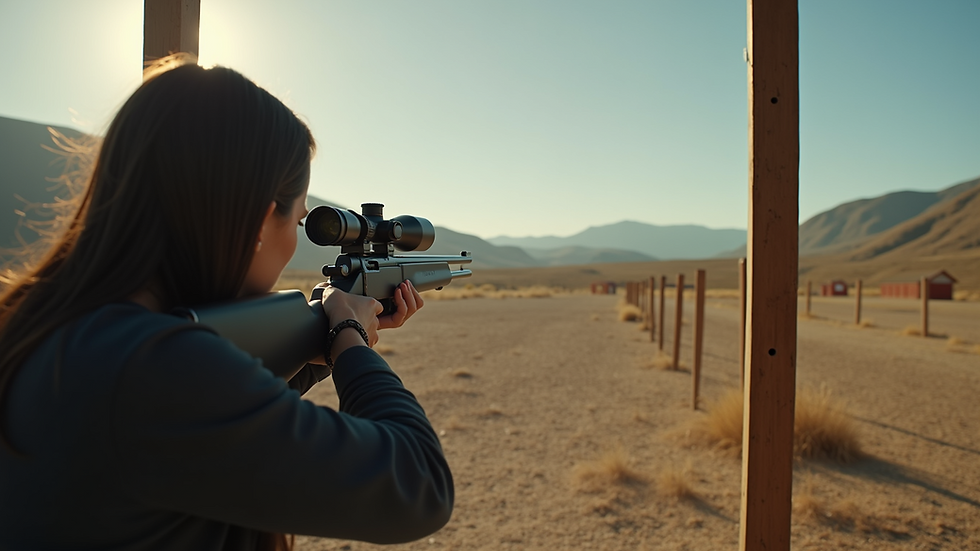The Benefits of Taking a Firearm Handling Course
- Hunttactical

- Sep 15
- 4 min read
Understanding how to safely and effectively handle firearms is essential for anyone who owns or plans to use a gun. Whether for personal protection, sport shooting, or hunting, proper training can make a significant difference in safety and confidence. Taking a firearm handling course offers numerous advantages that go beyond just learning how to shoot. This article explores the key benefits of enrolling in such a course and why it is a wise investment for responsible firearm owners.
Why Firearm Handling Skills Matter
Proper firearm handling is the foundation of gun safety. Without the right knowledge and skills, accidents can happen, sometimes with tragic consequences. A firearm handling course teaches essential principles such as:
Safe loading and unloading techniques
Correct grip and stance
How to identify and avoid common hazards
Proper storage and maintenance
These skills help reduce the risk of accidental discharge and ensure that the firearm is used responsibly. For example, learning how to safely clear a jam or malfunction can prevent dangerous situations during use. Additionally, understanding the mechanics of your firearm increases your confidence and control.

Key Advantages of a Firearm Handling Course
Enrolling in a firearm handling course provides several practical benefits that enhance your overall experience with firearms:
1. Enhanced Safety Awareness
Safety is the top priority when dealing with firearms. A structured course emphasizes the four fundamental rules of gun safety:
Treat every firearm as if it is loaded
Never point the firearm at anything you do not intend to shoot
Keep your finger off the trigger until ready to fire
Be sure of your target and what is beyond it
By internalizing these rules, you develop habits that protect you and those around you.
2. Improved Accuracy and Control
Proper training helps you develop better shooting techniques. Instructors guide you on how to:
Maintain a steady stance
Control your breathing
Align sights correctly
Manage recoil effectively
These skills lead to improved accuracy, making your shooting more effective and enjoyable.
3. Legal and Ethical Knowledge
A firearm handling course often covers important legal aspects, such as:
Local and federal firearm laws
Rights and responsibilities of gun owners
Ethical considerations in using firearms for self-defense or hunting
Understanding these topics helps you stay compliant with the law and act responsibly.
4. Confidence Building
Many new firearm owners feel nervous or unsure when handling guns. Training builds confidence by providing hands-on experience in a controlled environment. This confidence is crucial for making sound decisions under pressure.
5. Access to Expert Guidance
Courses are typically led by certified instructors with extensive knowledge and experience. They can answer your questions, correct mistakes, and provide personalized tips to improve your skills.

How long does a firearm safety course take?
The duration of a firearm safety course varies depending on the program and the depth of training offered. Generally, courses range from a few hours to multiple days. Here’s a breakdown of typical course lengths:
Basic safety courses: Usually 4 to 6 hours, covering fundamental safety rules and basic handling.
Comprehensive courses: Can last 1 to 3 days, including live-fire practice, legal education, and advanced techniques.
Specialized training: May extend over several days or weeks, focusing on specific skills like tactical shooting or hunting safety.
Choosing the right course depends on your goals and experience level. Beginners often benefit from shorter introductory courses, while experienced shooters may prefer more in-depth training.

Practical Tips for Choosing the Right Firearm Handling Course
Selecting the right course is crucial to maximize the benefits of your training. Consider the following factors:
Certification: Look for courses taught by certified instructors or recognized organizations.
Curriculum: Ensure the course covers safety, handling, legal issues, and live-fire practice.
Class size: Smaller classes allow for more personalized instruction.
Facilities: Check if the training location has a safe and well-maintained shooting range.
Reviews: Read feedback from past students to gauge the quality of instruction.
Additionally, verify that the course aligns with your specific needs, whether it’s self-defense, hunting, or sport shooting.
Continuing Education and Practice
Completing a firearm handling course is just the beginning. To maintain and improve your skills, regular practice and ongoing education are essential. Consider:
Attending refresher courses annually
Practicing at a shooting range regularly
Staying updated on changes in firearm laws
Joining shooting clubs or groups for community support
Consistent practice helps reinforce safe habits and sharpens your shooting abilities.
Embracing Responsibility as a Firearm Owner
Owning a firearm comes with significant responsibility. Taking a firearm handling course is a proactive step toward becoming a knowledgeable and conscientious gun owner. It equips you with the skills and mindset needed to handle firearms safely and effectively.
By investing time in proper training, you contribute to a safer environment for yourself, your family, and your community. Whether you carry a firearm for protection or enjoy shooting as a hobby, education is the key to responsible ownership.
Taking a firearm handling course is more than just learning how to shoot. It is about cultivating respect for firearms, understanding safety protocols, and developing skills that protect lives. If you own or plan to own a firearm, consider enrolling in a course today to gain the confidence and knowledge you need.






Comments